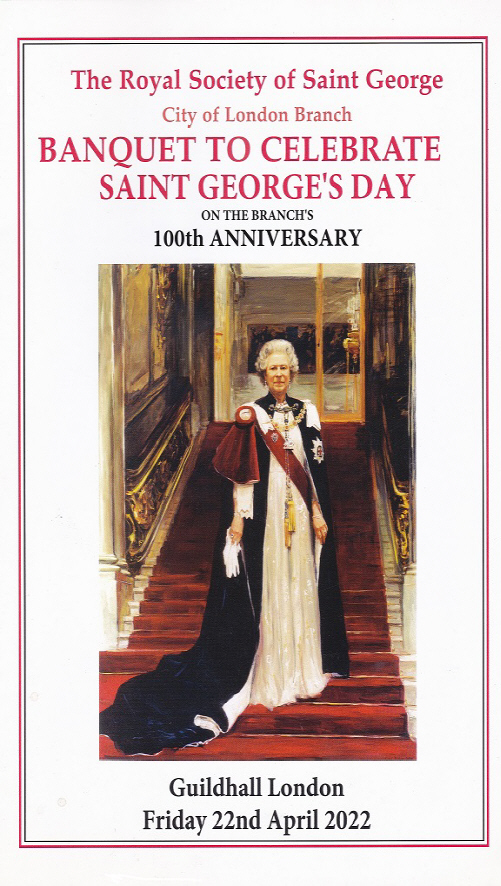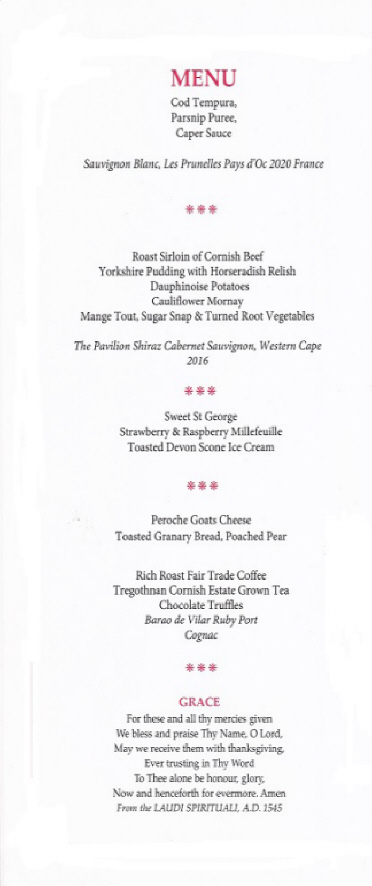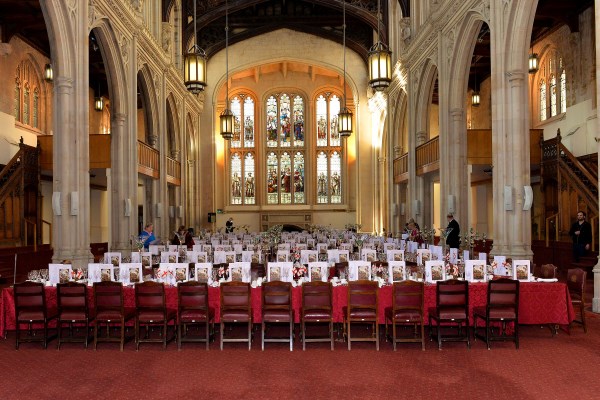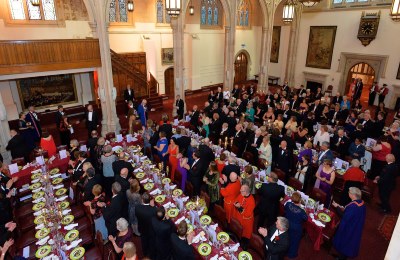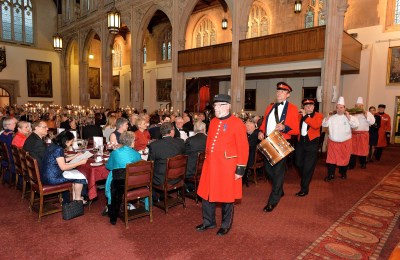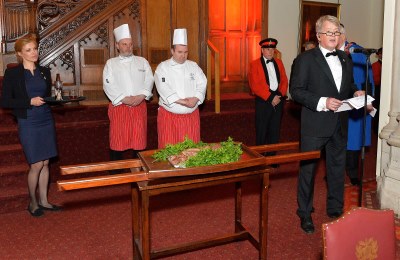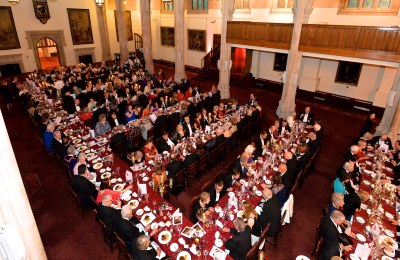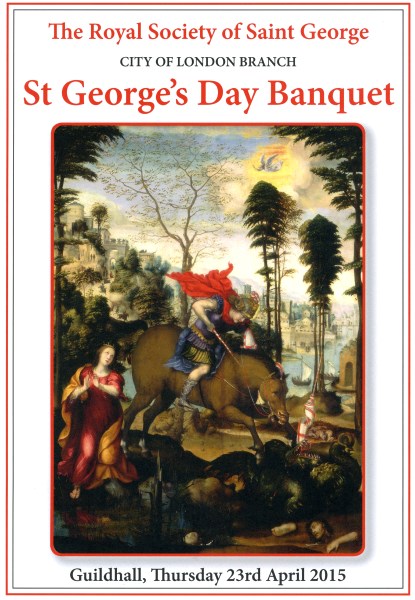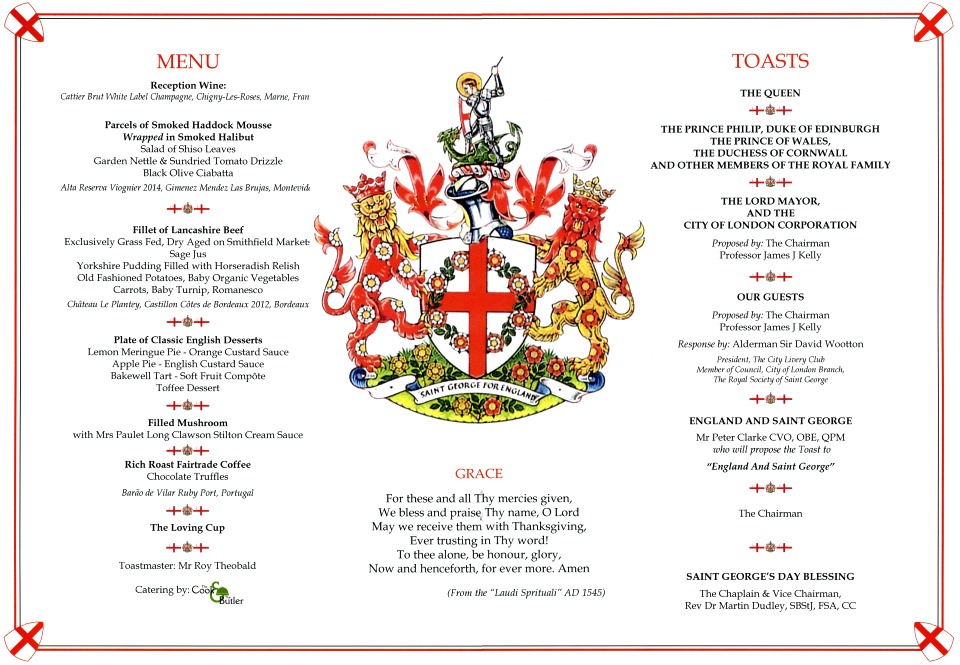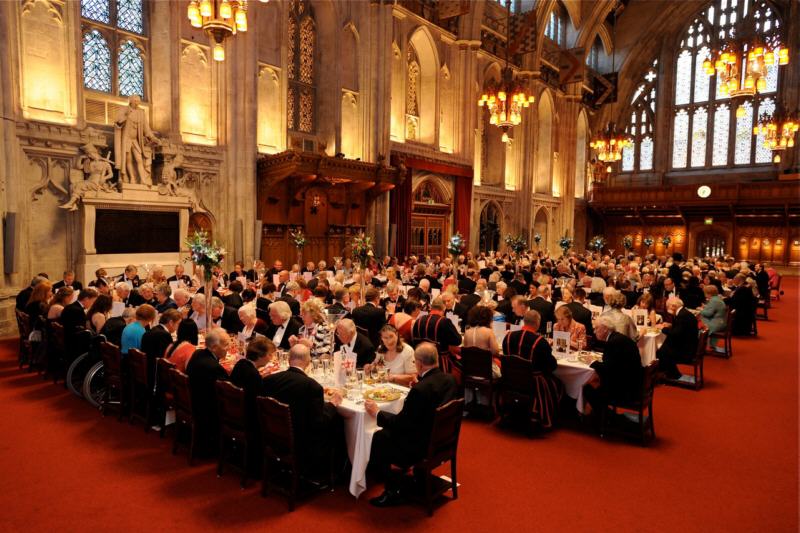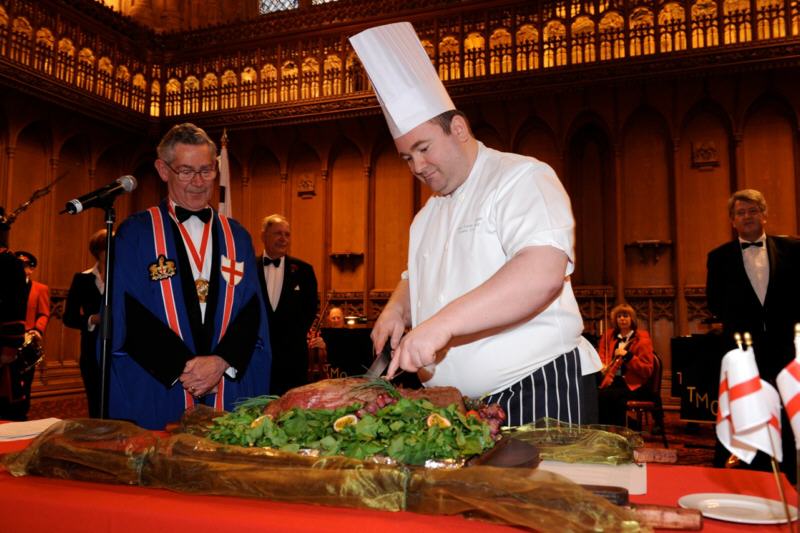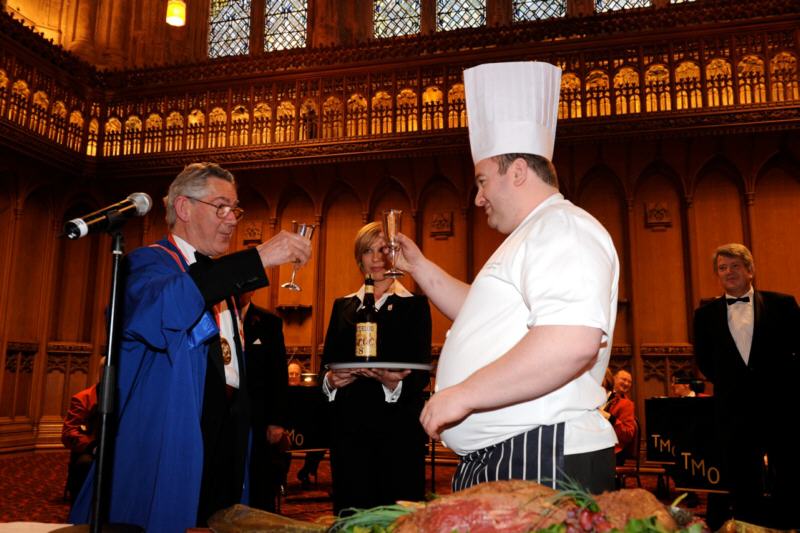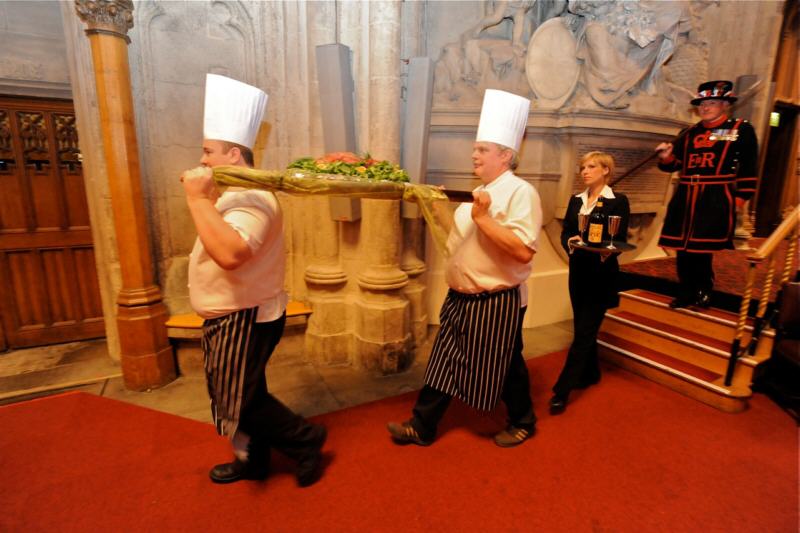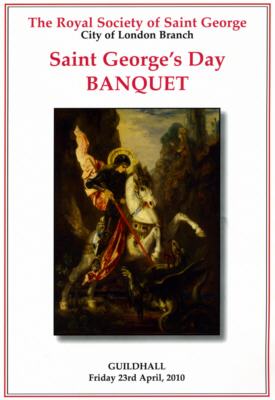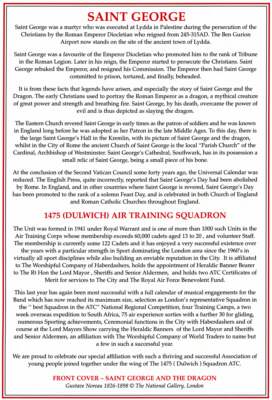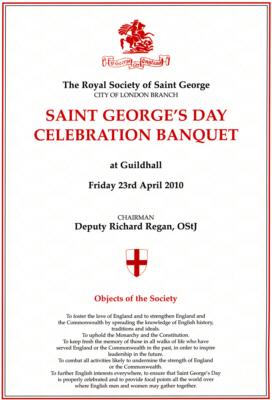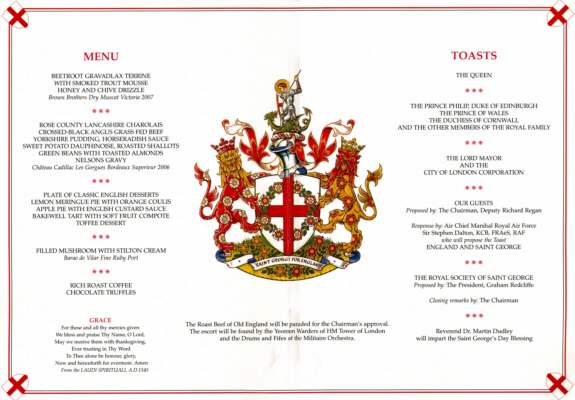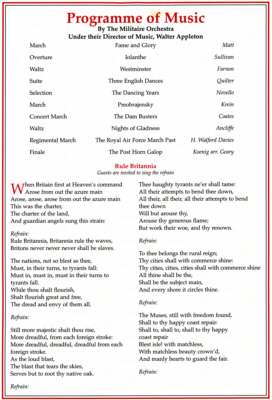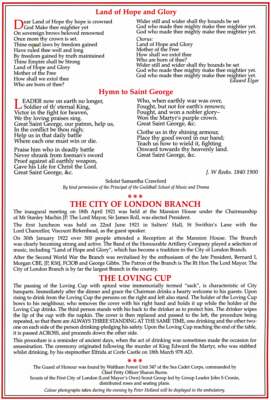
Tel: 020 7620 1818 email: cookandbutler@btconnect.com
The Royal Society of Saint George
www.royalsocietyofstgeorge.com
Installation Dinner
4th June 2025, Guildhall, City of London

![]()
Banquet To Celebrate St George's Day 100th Aniversary
22nd
April 2022, Guildhall, City of London
![]()
St George's Day Banquet
April 2019, Guildhall, City of London
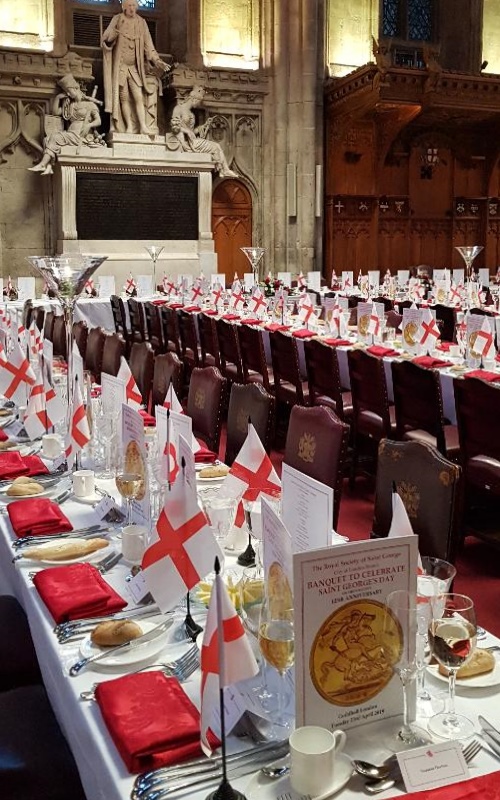
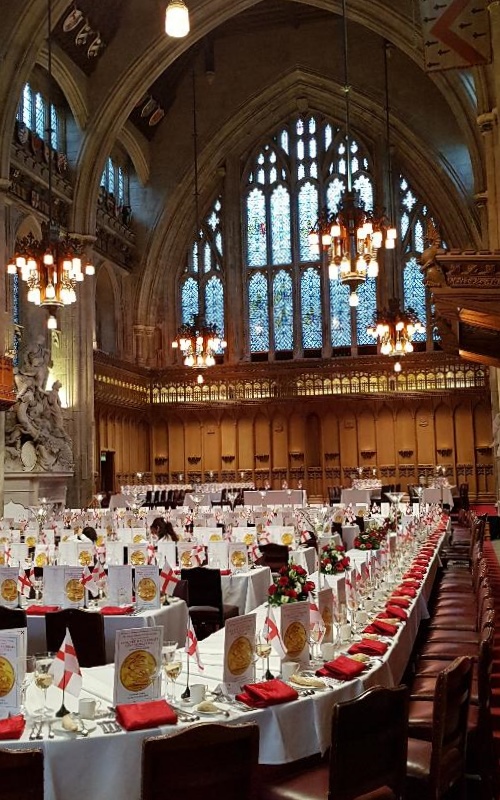
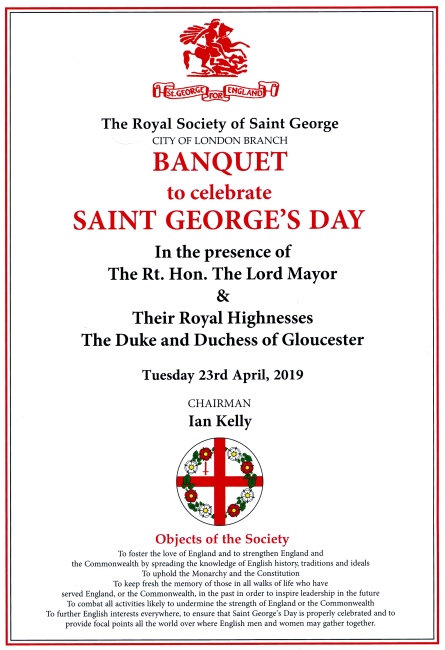
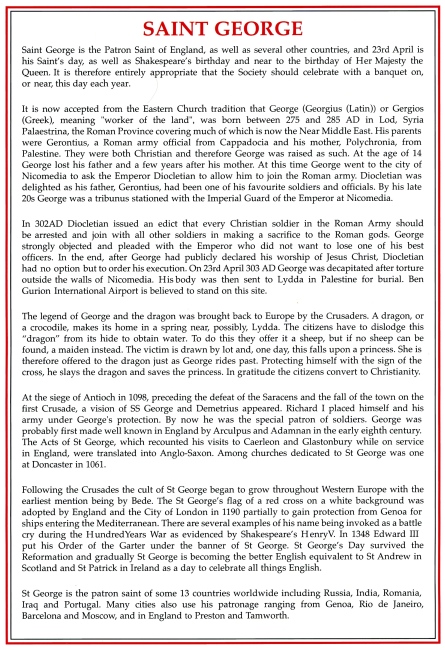
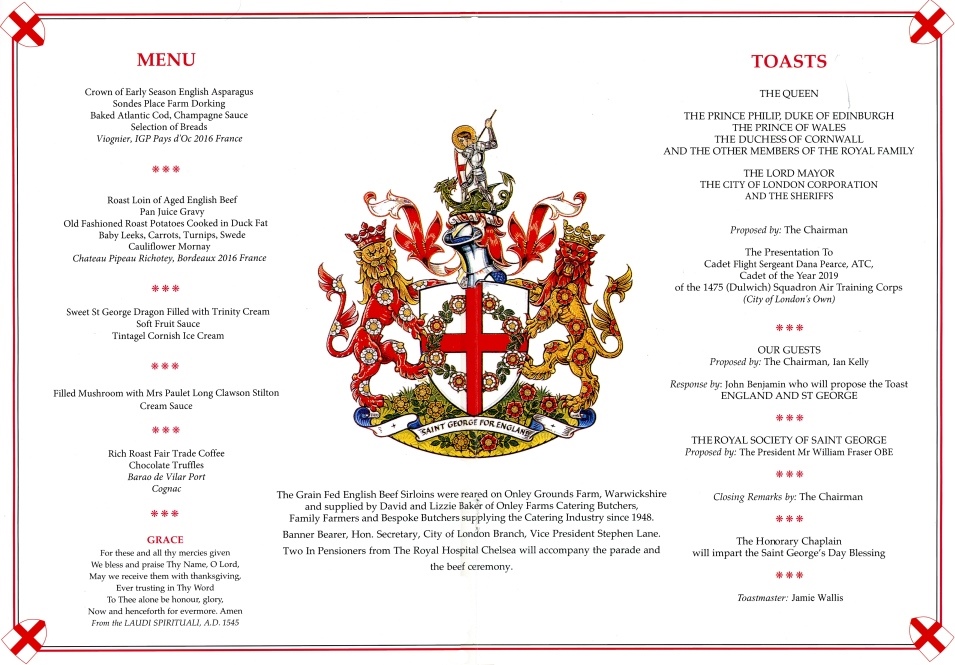
Saint George
Saint George is the Patron Saint of
England, as well as several other countries, and 23rd April is his Saint's
day, as well as Shakespeare's birthday and near to the birthday of Her
Majesty the Queen. It is therefore entirely appropriate that the Society
should celebrate with a banquet on,or near, this day each year.
It is now accepted from the Eastern Church tradition that
George (Georgius (Latin)) or Gergios (Greek), meaning "worker of the land",
was born between 275 and 285 AD in Lod, Syria Palaestrina, the Roman
Province covering much of which is now the Near Middle East. His parents
were Gerontius, a Roman army official from Cappadocia and his mother,
Polychronia, from Palestine. They were both Christian and therefore George
was raised as such. At the age of 14 George lost his father and a few years
after his mother. At this time George went to the city of Nicomedia to ask
the Emperor Diocletian to allow him to join the Roman army. Diocletian was
delighted as his father, Gerontius, had been one of his favourite soldiers
and officials. By his late 20s George was a tribunus stationed with the
Imperial Guard of the Emperor at Nicomedia.
In 302AD Diocletian issued an edict that every Christian
soldier in the Roman Army should be arrested and join with all other
soldiers in making a sacrifice to the Roman gods. George strongly objected
and pleaded with the Emperor who did not want to lose one of his best
officers. In the end, after George had publicly declared his worship of
Jesus Christ, Diocletian had no option but to order his execution. On 23rd
April 303 AD George was decapitated after torture outside the walls of
Nicomedia. His body was then sent to Lydda in Palestine for burial. Ben
Gurion International Airport is believed to stand on this site.
The legend of George and the dragon was brought back to
Europe by the Crusaders. A dragon, or a crocodile, makes its home in a
spring near, possibly, Lydda. The citizens have to dislodge this "dragon"
from its hide to obtain water. To do this they offer it a sheep, but if no
sheep can be found, a maiden instead. The victim is drawn by lot and, one
day, this falls upon a princess. She is therefore offered to the dragon just
as George rides past. Protecting himself with the sign of the cross, he
slays the dragon and saves the princess. In gratitude the citizens convert
to Christianity.
At the siege of Antioch in 1098, preceding the defeat of
the Saracens and the fall of the town on the first Crusade, a vision of SS
George and Demetrius appeared. Richard I placed himself and his army under
George's protection. By now he was the special patron of soldiers. George
was probably first made well known in England by Arculpus and Adamnan in the
early eighth century. The Acts of St George, which recounted his visits to
Caerleon and Glastonbury while on service in England, were translated into
Anglo-Saxon. Among churches dedicated to St George was one
at Doncaster in 1061.
Following the Crusades the cult of St George began to
grow throughout Western Europe with the earliest mention being by Bede. The
St George's flag of a red cross on a white background was adopted by England
and the City of London in 1190 partially to gain protection from Genoa for
ships entering the Mediterranean. There are several examples of his name
being invoked as a battle cry during the Hundred Years War as evidenced by
Shakespeare's Henry V. In 1348 Edward III put his Order of the Garter under
the banner of St George. St George's Day survived the Reformation and
gradually St George is becoming the better English equivalent to St Andrew
in Scotland and St Patrick in Ireland as a day to celebrate all things
English.
St George is the patron saint of some 13 countries
worldwide including Russia, India, Romania, Iraq and Portugal. Many cities
also use his patronage ranging from Genoa, Rio de Janeiro, Barcelona and
Moscow, and in England to Preston and Tamworth.

St George's Day Banquet
April 2015, The Old Library, Guildhall, City of London
May 2014, Armourers' Hall
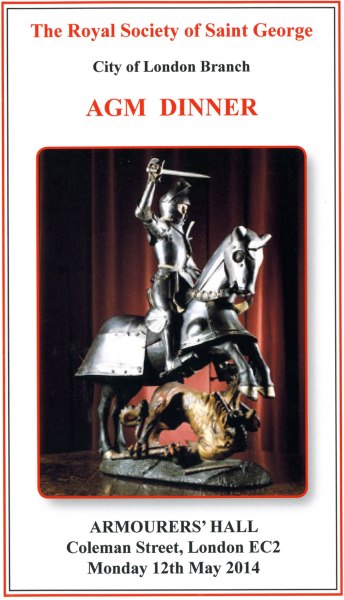

Armorial Bearings
Shield of Arms: The Cross of St. George and a wreath of
Roses, Red and White, have been combined to form the Armorial Bearings of
the Royal Society of St. George. Red and White Roses combined and called
“Tudor” Roses have been associated as the “plant badge” of England since the
end of the War of the Roses and well summarised by Shakespeare’s line:
“We will unite the White Rose and the Red, smile heaven upon this fair
conjunction.”
Crest: This is pretty self-explanatory. St. George is depicted as a Knight
on foot in combat with the Dragon and thrusting his spear into the jaws of
the monster, protecting himself all the while by his Shield of Arms charged
with the Cross of St. George, still part of the insignia, standing for
England, of the United Kingdom, being incorporated in the Union Flag.
Supporters: Two Lions have been chosen as typically English symbols to
support and protect the Shield of the Society. The Lions being made
particularly relevant to the said Royal Society of St. George, in having
roses, both Red and White, scattered upon their bodies, the Supporters
standing on a grassy mount from which Roses are shown growing. This
combination of Lions and Roses being designed to emphasise the Englishness
of the Royal Society of Saint George
Saint George
It is likely that St George was born in Cappadocia, in
what is now Turkey, in about the year 280 AD. From his physical description,
he was probably of Darian origin, because of his tall stature and fair hair.
He enlisted into the Cavalry of the Roman Army at the age of 17, during the
reign of the Emperor Diocletian and quickly established a reputation amongst
his peers, for his virtuous behaviour and physical strength, achieving the
rank of Miltenary or Tribunus Militum, an officer’s rank roughly equivalent
to a full Colonel, in charge of a regiment of 1,000 men and became a
particular favourite of his Emperor.
Diocletian, a skilled military tactician and strict disciplinarian, set
himself the task of rejuvenating the morale of the citizens of Rome by
reviving the prevailing traditions and paganism of the city. His second in
command was Galerius, the conqueror of Persia and an avid supporter of the
Pagan religion. As a result of a rumour that the Christians were plotting
the death of Galerius, an edict was issued that all Christian Churches were
to be destroyed and all scriptures were to be burned. Anyone admitting to
being a Christian, would lose his rights as a citizen, if not his life.
Many Christians feared to be loyal to their God; but, having become a
convert to Christianity, St. George acted to limit the excesses of
Diocletian's actions against the Christians. He went to the city of
Nicomedia where, upon entering, he tore down the notice of the Emperor’s
edict and gained great respect for his compassion towards Diocletian’s
victims. As news spread of his rebellion against the persecutions, St George
realised that as both Diocletian and Galerius were in the city, it would not
be long before he was arrested. He prepared for the event by disposing of
his property to the poor and freed his slaves.
Diocletian refused to acknowledge or accede to St George’s reasoned,
reproachful condemnation of his actions and consigned him to prison with
instructions that he be tortured until he denied his faith in Christ. St
George, having defended his faith was beheaded at Nicomedia near Lyddia in
Palestine on the 23rd of April in the year 303 AD. Stories of St. George's
courage soon spread and his reputation grew very quickly. He soon became
known in Russia and the Ukraine as the Trophy Bearer and his remains are
said to have been buried in the Church that bears his name in Lydda.
However, his head was carried to Rome, where it was preserved in the Church
that is also dedicated to him.
St. George became the Patron Saint of England in 1415 AD, when English
Soldiers under Henry V won the battle of Agincourt.
The City of London Branch
The inaugural meeting of the City of London Branch of The
Royal Society of Saint George, was held at The Mansion House on 18th April
1921 under the Chairmanship of Mr Stanley Machin JP. The Lord Mayor, Sir
James Roll, was elected as the first President.
The first luncheon of the new branch was held on 22nd June 1921 in Salters’
Hall, St Swithin’s Lane with the Lord Chancellor, Viscount Birkenhead, as
the guest speaker. On 30th January 1922 over 500 people attended a Reception
at the Mansion House. The Branch was clearly becoming strong and active.
During the banquet, the Band of the Honourable Artillery Company played a
selection of music, including “Land of Hope and Glory”, which has become a
tradition in the City of London Branch.
After the Second World War the Branch was revitalised by the enthusiasm of
the late President, Bernard L Morgan CBE, JP, KStJ, FCIOB and George Gibbs.
The Patron of the Branch is The Rt Hon The Lord Mayor. The City of London
Branch is by far the largest branch of the Society in the country Saint
George
